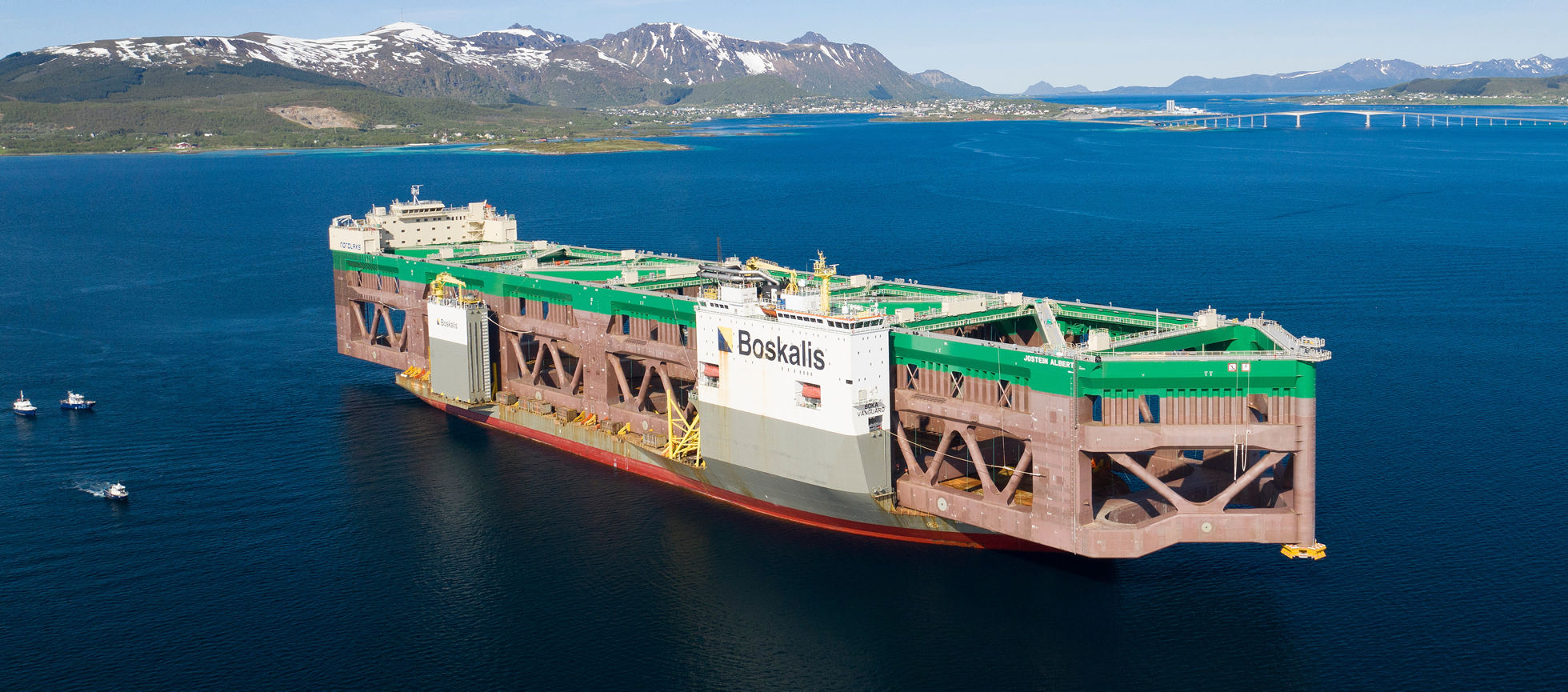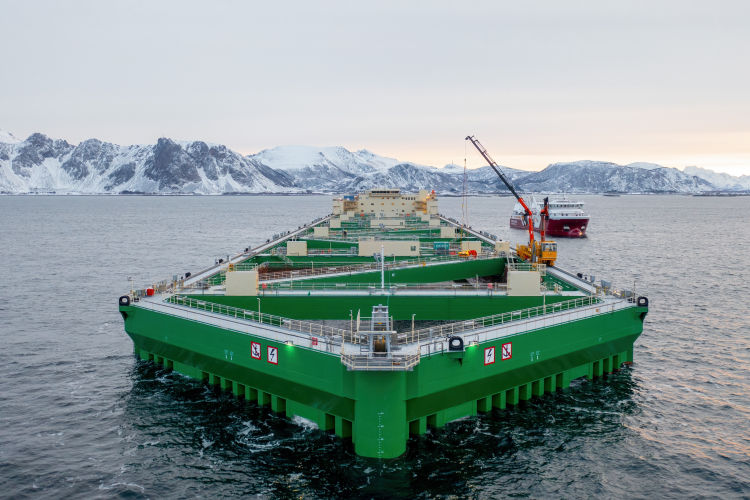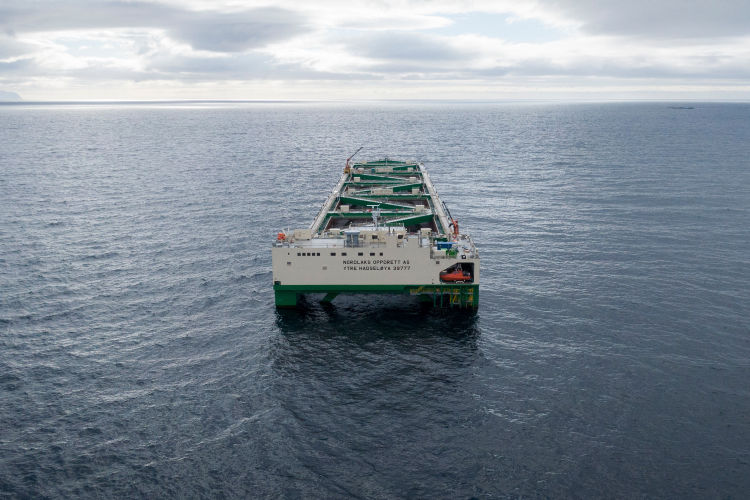The Ocean Farm "Jostein Albert"

The Ocean Farm “Jostein Albert” is located on the site “Ytre Hadseløy” in Hadsel municipality in Nordland. The location is approximately 5 kilometers from land and is the most exposed location for aquaculture in operation in Norway today.
The ocean farm “Jostein Albert” is the result of a large innovation and development project that Nordlaks started in early 2015. The project was a result of an innovation and development scheme initiated by Norwegian authorities, to speed up the technological development of the Norwegian aquaculture industry. Nordlaks was the first company to submit an application for development permits, and one of the first companies to realize and carry out the development project.
The Ocean Farm “Jostein Albert” has since 2022 concluded the development and test phase, and is today in aquaculture production for Nordlaks Oppdrett AS. Future plans include one production cycle every year, from stocking to delivery and slaughter. Since summer 2022, the third operating cycle is underway in “Jostein Albert”, with plans for ending the cycle early 2023 and new stocking of salmon in the spring of 2023.
Background
Development and construction of the Ocean Farm “Jostein Albert” would not have been possible without the Norwegian authorities’ initiative for furthering the technological development in the industry. This arrangement was set up in 2015 and was discontinued in 2017. The goal was to stimulate innovation and the development of technology to help solve area and environmental challenges in the aquaculture industry.
The basic idea behind the Ocean Farm project is that the area challenges in the aquaculture industry is closely linked to environmental and other challenges such as fish health and welfare. For us it was, and still is, obvious that the aquaculture industry needs access to sea area in order to develop further. The Ocean Farm represents the development of new technology that enables the use of new sea areas along the Norwegian coast for aquaculture and food production. The ability to use new areas also provides room for spreading the production of fish over both time and space. These are crucial prerequisites for controlling salmon lice through prevention and thus reducing the environmental impact of our industry.
The Ocean Farm “Jostein Albert” is among the absolute foremost projects in contributing to the development of a more exposed and eventually ocean-going (offshore) aquaculture industry.
Sharing insights
The granting of development permits also sets criteria of sharing insights from all phases of the development project. In order to meet these criteria, Nordlaks shares experiences, new knowledge and data from the ocean farm project in various ways. Some of the knowledge sharing takes place via publications that are available here. All of these are unfortunately only available in Norwegian language.
Location and monitoring of the sea floor
The authorities have granted a location permit for the Ocean Farm on Ytre Hadseløya (loc no. 39777), south-west of Hadseløya in Hadsel municipality in Vesterålen. Permission has been granted for 10,000 tonnes of MTB on the site, with a time limit until 31st of December 2025.
Prior to the start of operations at the site, Nordlaks has carried out surveys to document the zero state (state of nature) at the sea floor in the production zone and in the area around (transition zone).
While the sea farm is in operation, an adapted and extended environmental monitoring program is carried out to document whether and to what extent the operation affects the environment below and around the ocean farm. If the results of the environmental monitoring are good and justifiable, then Nordlaks can apply for a permanent permit for 10,000 tonnes of MTB.
The results from the monitoring program have been very good in the first two years of operation in the Ocean Farm. The environmental condition has been reduced from 1 (very good, i.e. best grade) to 2 (good) during the two two first production cycles. Nordlaks have documented both times that the environmental condition has improved during the operation, from halfway through production until just before slaughter. These are unusually good results, as the greatest stress on the seabed usually occurs in the last period before the slaughter when the fish are at their largest size. During the fallowing period (when the farm stays empty, which is required after every production cycle), we have documented a further improvement, so that the environmental condition ahead of each of the three production cycles have been 1 (very good). It has so far been documented that the environment is restored between each production cycle.
The results from the monitoring program are public and can be downloaded from the Directorate of Fisheries’ website. The most recent report was carried out in September 2022 and can be downloaded here.
Barentswatch also publishes the results of weekly lice counts as well as information on well boat calls etc. at the farm.
Technical data
- Length: 385 meter
- Width: 59,5 meter
- Depth: 37,75 meter
- Farming volume: 6 units á 69 000 m3. Each pen is up to 56 meters deep.
- Energy sources: Receives electrical power from the main grid. Backup generators in case of power outage.
The Ocean Farm “Jostein Albert” is 385 meters long, 59.5 meters wide and has a capacity of up to 10,000 tonnes of salmon. It has the same maximum density of salmon as any other aquaculture farm (25 kg per 1000 Liters of water; 2,5 % salmon and 97,5 % water). The density of salmon in the ocean farm is typically far below the limit, only approaching this limit during the last phase of the production cycle – when the salmon is ready for slaughter.
The ocean farm is anchored to the sea floor. The anchors are connected to the ocean farm through arotating turret in the bow section. This allows the ocean farm to rotate on the location according to weather conditions. It will always face the weather, bow first. The facility’s direction is determined by wind, wave and current direction. The rotating principle is an important feature in order to reduce the stress on the marine environment on the seafloor.
The Ocean Farm is connected to 11 anchors, each weighing 22 tonnes. Each anchor has a holding power of between 300 and 450 tonnes. The anchors are deployed in three groups, with four anchors per group to the north-west and south-west and a group of three anchors to the east. It is approximately 650 meters from the anchors to the site’s center point. The sea farm itself moves within a circle with a radius of 450 meters from the site’s center point.
In accordance with the Norwegian Coastal Administration’s regulations, Havfarmen is labeled as a farming facility. This includes, among other things, flashing lights on the outer edges of the farm, in order to be visible for ships.


Economic ripple effects of the project
The Havfarm project creates major economical ripple effects, particularly in our part of northern Norway. With 13 new permits for aquaculture, Nordlaks has been able to increase the output significantly. This in turn also increases the need for constructing new land based facilities for the production of stocking fish (baby salmon), live fish carriers (ships), the expansion of factories for slaughtering and value added processing of salmon, farming and service boats as well as technical equipment for the sea farm itself. In total, Nordlaks had plans for investing more than NOK 5 billion in the Ocean Farm project and other required innovations along the value chain. This is the biggest investment project in the company’s history, and among the biggest industrial investments in the mainland economy in Northern Norway ever. The Havfarm project contributes to the creation of new jobs and already increases significant ripple effects from Nordlaks’ activity. From 2017 until 2022, the employment in Nordlaks alone has increased from around 500 to over 800.
The Ocean Farm was built in China, but is a Norwegian-developed project. Of the suppliers in the project, there is a preponderance of Norwegian companies. The Norwegian supplier industry is a world leader in both maritime and aquaculture technical solutions, and the Ocean Farm project contributed to bringing these environments together and using their combined knowledge for developing new solutions for the aquaculture industry.
Partner companies (suppliers etc.)
Maritimt/offshore
-
Yantai CIMC Raffles Offshore Ltd (Shipyard)
-
Boskalis (Transport of the Ocean Farm from China)
-
Siem Offshore (Laying out of mooring, float-off og hook-up)
-
DOF (Float-off og Hook-up)
-
Boa (Float-off og hook-up)
-
Seaworks (layout of shore power cable)
-
Seasystems (former- Scana) – turret, mooring and shore power cable, incl. coordination of deployment/float-off/hook-up
-
Nexans (cabel – through Scana)
-
Vryhof (Anchor – through Scana)
-
Ramnäs (Chain – through Scana)
-
SAP (Hull monitoring)
-
Kongsberg (Sensors and monitoring)
-
Siemens (Power and automation)
-
Scanmatic (Sensors)
-
Techano (Rail mounted service units and cranes)
-
7Waves (Structural design)
-
First Ocean Associates (Planning and project management/execution of mooring operations)
-
Semar (Planning and project management/execution float-off and hook-up operations)
-
Core Marine (Planning and project management/execution of electrical cables between the ocean farm and the main grid)
-
DNV GL (Verification/class)
-
Servi (Winches)
-
Jotun (Paint)
-
Rolls Royce (Thrusters, now Kongsberg)
-
Skuld (Incurance)
-
Fearnleys/MIL Shipping (Ship brokerage)
-
Premas (Maintenance system)
Havbruk
-
Akva Group (Feeding system)
-
Selstad (nets and affiliated system for handling)
-
Optimar (Closed system for handling dead fish on board)
-
Lift-up (system for collecting dead fish at the bottom of the pen)
-
Berg Elektro (Electric installation)
-
Lofoten Elektro (Electric installation)
-
Skarvik (assistance for completion)
-
Skretting (Feed, and sunglasses.)
-
Åkerblå (Veterinary services)
-
Akvaplan-niva (Environmental monitoring)
-
Skarsvaag (personell carrier NORA)
-
Sintef Ocean (Model construction and testing)
-
Hordafôr (Fish silage/preparedness)
-
Ocein (ROV (remotely operated vehicle) for cleaning the nets)
-
Blueye (Inspection ROV)
-
Pump Supply (Pumps for ROV)
-
Multiconsult (Design, and contributions within different diciplines)
-
Fugro Oceanor (Delivery of equipment for documenting weather conditions at the site)
-
NSK Ship Design (Design)
-
Aanderaa/Xylem (Oxygen measuring equipment)
-
SAIV (CTDO-sonde)
-
SJ Dykk (Diving services in relation to connecting ocean farm to the main grid)
-
Dykkerkompaniet (Diving services related to the technical completion of the farm)
-
Norwegian Veterinary Institute (Professional responsibility for the documentation program regarding fish health)
Other suppliers
-
Allweiler (pumps)
-
Brødrene Dahl (vents)
-
Jets (Sanitary system)
-
Viking Norsafe (rescue equipment and Fast Daughter Craft)
-
IMS (Water tight sliding doors for compartmentalisation of the construction)